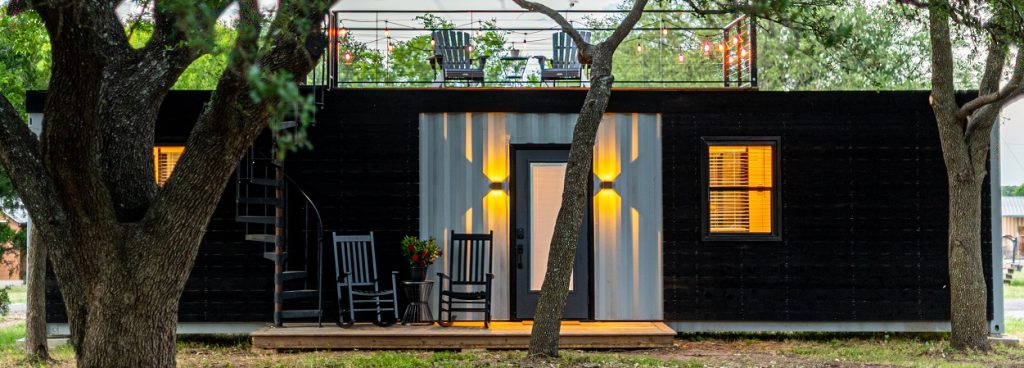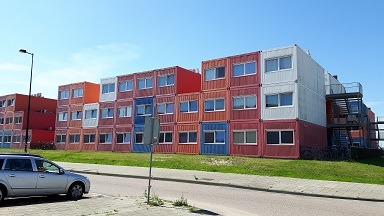
Off the Beaten Path
Companies that convert shipping containers are defying traditional architectural rules, and turning shipping materials into real estate. The concept was awarded a U.S. patent in 1989, and it has captured the popular imagination in recent years. Now, it’s an international trend that’s found its adherents in U.S. minimalist culture. For one thing, how else could a 40-foot home in the Philadelphia suburbs be priced under $100K, as CW Dwellings of Wayne, Pennsylvania advertises?
Sure, but aren’t they sort of… industrial? They can be. People are looking for a vacation home or tiny guest house with low environmental impact might appreciate a straightforward, minimally processed exterior look. Remote workers might need an extra space to create a separate office or store their gear, and care more about function than frills. But that doesn’t mean container homes aren’t also fashionable — and, as Dwell Magazine proves, even breathtakingly stylish!
Intrigued? Here’s how it all works.
Nuts and Bolts
First, the company and the customer come to a meeting of the minds. How much space does the customer want? How many rooms and bathrooms? Does the customer want a central HVAC system?
What about custom-designed features like a sound system, panoramic windows, a ramp or a roof deck, or special interior painting? Or a platform with steps? What about an artfully designed and raised roof shield? How about a solar water pump or battery-powered electricity, or a foundation nestled into the home site’s rocky surroundings, anchored by pylons?
Once the project is conceptualized, the container dwelling company provides overall pricing and timing estimates, takes a down payment, and orders the containers.
The making of a container home starts with bumping out the metal work. This turns eight feet of container space into ten feet of living space. This step is done repeatedly for larger container homes. And it’s done with precision, so the container spaces can be attached and stacked, forming larger structures.
A wood frame is constructed to hold the insulation, plumbing and electrical work, and walls. A new plywood floor is constructed, completely replacing the surface of the container floor, to remove all traces of possibly toxic chemicals used in the container’s previous life.
Next, cable outlets in addition to doors and windows created. The plumbing and wiring are installed. The company tests the connections, then puts up the drywall, paints the interior, and installs lighting, laminate flooring, baseboards, kitchen features and a water heater.
Once the container home is in shape for locally required inspections, it’s trucked to the buyer’s land, lifted off the flat-bed truck, installed on the property, and grounded for storm safety.
Speaking of grounding: If a shipping container home is not firmly and permanently attached to the ground, a lender will likely classify it as a mobile home. This can make a mortgage application a non-starter. A purchaser might need to apply for a personal loan, depending on the circumstances, the home specs, and the land involved.
Chic and Handy Student Housing

In 2005, Amsterdam dealt with a student housing shortage by calling on a local business, Tempohousing, to create the Keetwonen campus. The work encompassed more than a thousand shipping container dorms and common spaces. The recycled containers were put together as multi-tier buildings, buttressed and linked by functional scaffolding. Other Tempohousing shipping container projects have run the gamut: from homeless shelters, to temporary, festival-focused hotels, to waterside offices, to a pop-up Tesla showroom in France.
Colleges and art studios in the United States have also used the container approach. In late 2020, for the College of Idaho, the indieDwell company installed dorms with kitchens made of recycled shipping containers. Another architectural design firm constructed a media studio for Bard College out of shipping containers and installed them in a single day. The manufacturing was done by SnapSpace Solutions, which uses recycled shipping containers to create structures that are “modern, chic, and disaster-resistant.”
By now, readers will have noticed how often these structures are fashioned out of recycled steel. Although they’re obviously not as ecofriendly, new containers are also available on the market to convert into living space.
☛ Note: Shipping container homes are comparable in many ways to tiny homes. Learn more in our Brief Guide to Buying a Tiny House.
Garage homes and apartments are also a thing! And by garage, we don’t mean grunge. These aren’t oily, dank, and cobweb-ridden spaces. A garage home can be as aesthetically pleasing as it is affordable. Along similar lines is the barn home (see also: pole barn home or barndominium). Some of these alternative building styles are quite the opposite of tiny. Yet they, too, can be very quickly installed and relatively inexpensive.
Real Estate and Container Homes

If you are buying real estate and plan to add a container home, be sure not to cut corners on due diligence. Your purchase will need to be contingent on zoning approval. If the property is subject to a homeowners’ association, check for pertinent restrictions on the placement and appearance of dwelling units or non-traditional structures.
To orient your planning, you might find the Discover Containers website a helpful place to begin a review of state regulations impacting container homes. State laws change, of course. The three most container-friendly states at this time, according to Discover Containers, are Texas, California, and Tennessee. Other notably supportive states include Alaska, Oregon, Missouri, and Louisiana.
☛ Note: Deed restrictions are not the same as zoning rules. Here is a brief explanation of deed restrictions and how they affect home buyers’ rights to construct or install alternative structures.
In the throes of the Covid-19 pandemic, the Miami REALTORS® group noted the pressing need for single-unit homes in South Miami. Together with the National Association of REALTORS® and city and county leaders, the group set out to offer affordable container homes to eligible buyers.
The group brought in home loan companies willing to finance the homes and approved to lend to beneficiaries of housing assistance. These compact and charming South Miami container homes, priced at $160,000, will be deed-restricted as affordable housing for 20+ years.
To Sum It All Up
Container homes are usually efficient and eco-friendly. Many shipping container homes are moveable, yet most can last decades right where they are — especially when they’re expertly insulated and have additional siding or other fortifying elements.
Hopeful buyers should research the local zoning laws, building codes, any relevant associations and aesthetic review boards, and deed restrictions. A real estate attorney can help the buyer understand what may and may not be done, and protect the value of the investment by following the rules. Speaking with insurers in advance is also important. Insurance policies differ, depending on the land and the style of the home involved.
In a time when affordable housing is hard to come by, shipping container homes are becoming popular among communities that were once unfamiliar with them. We hope this brief introduction to container homes offers our readers some insight into this alternative real estate idea.
Supporting References
Bill Gassett for Maximum Real Estate Exposure (Re/Max®): Shipping Container Homes: What to Know Including Costs and Design (Feb. 22, 2021).
DiscoverContainers.com: Shipping Container Zoning, Permits, and Building Codes (updated Dec. 29, 2020).
Tobias Roberts for BuildWithRise.com: Twelve Tips You Need to Know Before Building a Shipping Container Home (Jan. 18, 2018).
The Miami Association of REALTORS® (chartered by the National Association of REALTORS®): The South Miami Shipping Container Home Is Ready!
Photo credits: Jed Owen, via Unsplash; Valdas Miskinis and Frank Magdelyns, via Pixabay.
